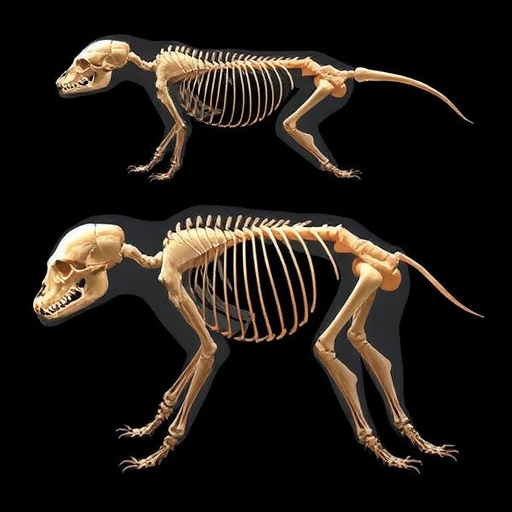In an exciting new study, researchers have ventured into the complex world of hemiplegia, which is a condition characterized by the paralysis of one side of the body. This groundbreaking research, published in BMC Neuroscience, highlights the anatomical and behavioral characterization of three distinct hemiplegic animal models. These findings could have profound implications for our understanding of brain injuries and the development of therapeutic strategies for stroke and other neurological disorders. The study reveals intricate details of how different animal models exhibit various responses to cerebral injuries, presenting not only a plethora of data but also offering new avenues for future research.
The three hemiplegic models studied in this research include rat, mouse, and non-human primate models. Each model presents unique advantages and challenges that contribute significantly to the understanding of hemiplegia. By using these models, the researchers were able to obtain a broad spectrum of insights regarding the anatomical and behavioral consequences of unilateral brain lesions. This research is particularly valuable as it sets the stage for future studies aimed at developing effective rehabilitation techniques for individuals suffering from hemiplegia due to stroke or other disorders.
The rat model has long been a staple in neurological research due to its relative ease of manipulation and observable behaviors. In this study, the researchers utilized a well-established surgical method to induce hemiplegia in rats, closely monitoring their recovery process. They documented not only the motor deficits but also the compensatory behaviors exhibited by the rats in response to their impairment. The integration of behavioral observations with anatomical assessments allowed for a multidimensional understanding of the impact of hemiplegia on the rats’ daily activities and interactions.
Moving on to the mouse model, it became evident that while these animals offered the potential for genetic manipulation, they also presented unique behavioral challenges. The researchers noted significant variations in recovery trajectories, with some mice showing remarkable resilience, while others struggled considerably with their impairments. The study highlighted the importance of considering genetic factors that may influence behavioral outcomes after experiencing hemiplegia. This understanding is critical for further developmental work in gene therapy and other innovative treatments.
The non-human primate model introduced an element of complexity that the other models could not replicate. Primate research is notably more expensive and ethically sensitive; however, the behavioral and anatomical similarities to humans render these models invaluable. The study’s findings derived from this model underscored the possibility that non-human primates exhibit more realistic responses that parallel human conditions of hemiplegia. Understanding these intricate responses may lead researchers to more effective rehabilitation protocols, informed by natural behavioral adaptations that evolve post-injury.
In an analysis of the anatomical changes across these three models, the researchers used advanced imaging techniques to visualize brain structure alterations following induced hemiplegia. This aspect of the study was revolutionary, as it provided real-time insights into how hemiplegia affects brain composition. Specific focus was placed on regions critical for motor functions, laying the groundwork for exploring neuroplasticity. The results revealed significant neuronal loss and alterations in the synaptic landscape, suggesting that hemiplegia goes far beyond simple motor impairment and poses serious threats to neurological integrity.
Moreover, the study took a closer look at how these anatomical changes correlated with behavioral deficits. The researchers devised a range of tests to assess motor skills, cognitive functions, and social interactions among the hemiplegic models. Results indicated that more severe anatomical disruptions coincided with amplified behavioral deficiencies. This correlation emphasizes the need for comprehensive studies in neurology that incorporate both anatomical and behavioral components, as it enhances our grasp of the interconnectedness of brain disorders and their behavioral manifestations.
In discussing the implications of this research, the potential for translational medicine was evident. The insights garnered from the anatomical and behavioral mapping of these hemiplegic models could guide clinical practices. The study opens doors for novel rehabilitation approaches, focusing not only on physical recovery but also on emotional and cognitive rehabilitation. As professionals begin to understand the broader spectrum of hemiplegia, more targeted, holistic recovery strategies can be designed that address various aspects of patient well-being.
Additionally, this research sets the stage for incorporating advanced technology in future investigations. The possibilities that arise from utilizing artificial intelligence and machine learning are staggering. As data collection expands, AI can assist in recognizing patterns and predicting outcomes, which in turn can influence treatment options tailored to individual patient profiles. This research done by Liu and colleagues establishes a vital foundation for future explorations driving the neurorehabilitation field forward.
The ethical considerations surrounding animal research cannot be overlooked. The authors of the study emphasized an extreme commitment to ethical principles, advocating for guidelines that ensure the humane treatment of animal subjects. A growing awareness of animal welfare underscores the importance of responsible research practices, particularly in studies aiming to make significant advancements in medical science.
Collaborative efforts among researchers from various disciplines were also highlighted within the study. Such collaboration is increasingly pivotal in driving forward complex medical advancements. Combinations of expertise from neurology, behavioral science, systems biology, and computational modeling can lead to innovative solutions that would otherwise remain unexplored in siloed research environments. As scientists unite to unravel the intricacies of hemiplegia, the broader scientific community stands to gain from their findings.
This inquiry into hemiplegic animal models undoubtedly represents a substantial leap in our understanding of neurologic function and recovery. Moreover, it underscores the pressing need for ongoing research in stroke recovery and brain injury rehabilitation. With ongoing innovations in methodology and increased understanding of behavioral and anatomical correlations, future studies can refine therapeutic approaches to enhance recovery for humans afflicted with similar conditions.
Through these collective efforts, researchers can forge a path toward breakthroughs that offer hope to countless individuals facing the repercussions of hemiplegia. In light of the potential for improved rehabilitation strategies, anxious minds now ponder the intriguing question: Could we soon witness a shift in how hemiplegic patients recover, thanks to the foundational knowledge provided by studies such as this one?
The future holds remarkable promise as investigative endeavors focused on hemiplegic models gain momentum, offering a glimpse into an era where recovery from neurological injuries becomes increasingly attainable for all. Studying animal models will continue to shed light on the profound relationships between brain anatomy, behavior, and recovery, leading to possibilities that once seemed unattainable.
Overall, this seminal research piece has opened discussions surrounding the intricacies of hemiplegia, paving pathways for future inquiry and innovation. It stands as a testament to the importance of comprehensive studies in the field of neuroscience, calling upon researchers to innovate and collaborate to enhance treatment and rehabilitation for those affected by neurological impairments.
By synthesizing findings from anatomical assessments and behavioral characterizations, the study moves toward a holistic understanding that is essential for the clinical application. As this work progresses, it ignites the spirit of innovation necessary to tackle the challenging pursuit of effective interventions for hemiplegic patients.
Subject of Research: Hemiplegic animal models and their anatomical and behavioral characteristics
Article Title: Anatomical and behavioral characterization of three hemiplegic animal models
Article References:
Liu, M., Xu, L., Cheng, G. et al. Anatomical and behavioral characterization of three hemiplegic animal models.
BMC Neurosci 26, 44 (2025). https://doi.org/10.1186/s12868-025-00961-9
Image Credits: AI Generated
DOI: 10.1186/s12868-025-00961-9
Keywords: Hemiplegia, animal models, neuroscience, rehabilitation, brain injury, stroke recovery.
Tags: anatomical characterization of hemiplegiabehavioral responses to brain injuriescomplex conditions in animal modelsfuture research avenues in neurosciencehemiplegic animal modelsimplications for stroke rehabilitationneurological disorders researchrat mouse non-human primate modelsstudying hemiplegia in neurosciencetherapeutic strategies for hemiplegiaunderstanding brain injuriesunilateral brain lesions studies





